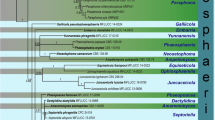Abstract
A new coelomycetes fungal species, Pestalotiopsis pallidotheae, is described. This endophytic fungus, isolated from a leaf of Japanese andromeda (Pieris japonica), has knob-tipped appendages on the apical and basal cells of the conidia. The conidial morphology is similar to that of Pestalotiopsis theae except that the color of the median cells is paler in P. pallidotheae. Molecular analyses of the ITS1-5.8S rRNA-ITS2 site placed P. pallidotheae in a group different from P. theae.


Similar content being viewed by others

References
Felsenstein J (1985) Confidence limits on phylogenies: an approach using the bootstrap. Evolution 39:783–791
Guba EF (1961) Monograph of Monochaetia and Pestalotia. Harvard University Press, Cambridge
Hall TA (1999) BioEdit: a user-friendly biological sequence alignment editor and analysis program for Windows 95/98/NT. Nucleic Acids Symp Ser 41:95–98
Hawksworth DL (2005) Host specificity in Pestalotiopsis. Mycol Res 109:5
Jeewon R, Liew ECY, Hyde KD (2002) Phylogenetic relationships of Pestalotiopsis and allied genera inferred from ribosomal DNA sequences and morphological characters. Mol Phylogenet Evol 25:378–392
Jeewon R, Liew ECY, Simpson JA, Hodgkiss IJ, Hyde KD (2003) Phylogenetic significance of morphological characters in the taxonomy of Pestalotiopsis species. Mol Phylogenet Evol 27:372–383
Jeewon R, Liew ECY, Hyde KD (2004) Phylogenetic evaluation of species nomenclature of Pestalotiopsis in relation to host association. Fungal Divers 17:39–55
Kishi K (1994) Production of pycnidia and acervuli by agar-leaf disk method (in Japanese). Ann Phytopathol Soc Jpn 60:345
Kishino H, Hasegawa M (1989) Evaluation of the maximum likelihood estimate of the evolutionary tree topologies from DNA sequence data, and the branching order in Hominoidea. J Mol Evol 29:170–179
Lee S, Crous PW, Wingfield MJ (2006) Pestalotioid fungi from Restionaceae in the Cape Floral Kingdom. Stud Mycol 55:175–187
Liu AR, Xu T, Guo LD (2007) Molecular and morphological description of Pestalotiopsis hainanensis sp. nov., a new endophyte from a tropical region of China. Fungal Divers 24:23–36
Nag Raj TR (1993) Coelomycetous anamorphs with appendage-bearing conidia. Mycologue Publications, Waterloo, Ontario
Posada D, Crandall KA (1998) Modeltest: testing the model of DNA substitution. Bioinformatics 14:817–818
Saitou N, Nei M (1987) The neighbor-joining method: a new method for reconstructing phylogenetic trees. Mol Biol Evol 4:406–425
Steyaert RL (1949) Contribution à l’étude monographique de Pestalotia de Not et Monochaetia Sacc. (Truncatella gen. nov. et Pestalotiopsis gen. nov.). Bull Jard Bot Brux 19:285–354
Steyaert RL (1953) New and old species of Pestalotiopsis. Trans Br Mycol Soc 36:81–89
Steyaert RL (1954) Concerning some South African Pestalotiopsis Steyaert. Bothalia 6:379–383
Steyaert RL (1961) Type specimens of Spegazzini’s collections in the Pestalotiopsis and related genera (Fungi Imperfecti: Melanconiales). Darwiniana 12:157–190
Swofford DL (2002) Phylogenetic analysis using parsimony (PAUP). Version 4.0b. Sinauer Associates, Sunderland
Tanabe AS (2007) Kakusan: a computer program to automate the selection of a nucleotide substitution model and the configuration of a mixed model on multilocus data. Mol Ecol Notes 7:962–964
Wei JG, Xu T (2004) Pestalotiopsis kunmingensis sp. nov., an endophyte from Podocarpus macrophyllus. Fungal Divers 15:247–254
Wei JG, Xu T, Guo LD, Liu AR, Pan XH, Zhang JC, Yuan GQ (2005) Delimitation of Pestalotiopsis species based on morphological and molecular phylogenetic characters (in Chinese). J Guangxi Agric Biol Sci 24:304–313
Wei JG, Xu T, Guo LD, Zhang Y, Pan XH (2007) Endophytic Pestalotiopsis species associated with plants of Podocarpaceae, Theaceae and Taxaceae in southern China. Fungal Divers 24:55–74
White TJ, Bruns T, Lee S, Taylor J (1990) Amplification and direct sequencing of fungal ribosomal RNA genes for phylogenetics. In: Innis MA, Gelfand DH, Shinsky JJ, White TJ (eds) PCR protocols: a guide to methods and applications. Academic Press, San Diego
Acknowledgments
The authors thank Dr. Kobayashi for presubmission review. This study was supported by National Institute of Agrobiological Science Genebank to K.W.
Author information
Authors and Affiliations
Corresponding author
About this article
Cite this article
Watanabe, K., Motohashi, K. & Ono, Y. Description of Pestalotiopsis pallidotheae: a new species from Japan. Mycoscience 51, 182–188 (2010). https://doi.org/10.1007/s10267-009-0025-z
Received:
Accepted:
Published:
Issue Date:
DOI: https://doi.org/10.1007/s10267-009-0025-z



